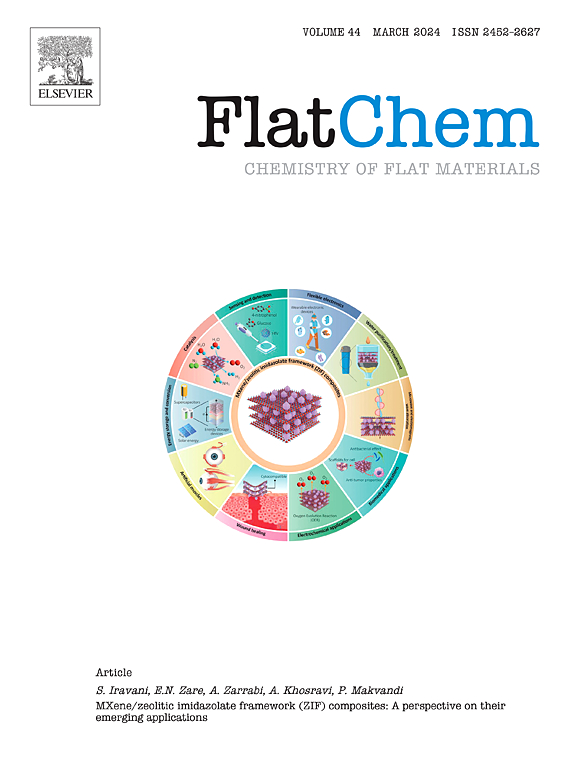Tailored nanoarchitectonics of PPy/g-C3N4/MnO2 hybrid on NiCo LDH for enhanced energy storage in supercapacitors
IF 6.2
3区 材料科学
Q2 CHEMISTRY, PHYSICAL
引用次数: 0
Abstract
The growing demand for efficient energy storage devices holding high specific energy has accelerated the search for advanced electrode materials. Transition metal-based layered double hydroxides (LDHs), particularly those containing nickel (Ni) and cobalt (Co), have emerged as promising candidates due to their tunable layered structure and chemical composition. In this study, LDH and its hybrids were prepared using a simple hydrothermal technique. In addition, X-ray diffraction (XRD) measurements approve the presence of H2O molecules and carbonate anions in the interlamellar space due to their extended interlayer spacing. The quaternary NiCo LDH/manganese dioxide (MnO₂)/polypyrrole (PPy)/graphitic carbon nitride (g-C₃N₄) hybrid nanocomposite exhibits a specific capacitance of 2389 F/g at 1 A/g, with 88 % retention after 5000 cycles at a higher current density of 10 A/g. The superior electrochemical performance is accredited to reduced aggregation and enhanced electronic conductivity. Charge storage kinetics were analysed using Dunn's method and power law, reveals increased diffusive contribution in the quaternary nanocomposite. A hybrid supercapacitor device was fabricated using quaternary hybrid as cathode and activated carbon (AC) as anode delivers a high specific capacitance of 260 F/g at 1 A/g, with 95 % cyclic stability after 10,000 cycles. The assembled device achieves a specific energy of 82 Wh/kg at a specific power of 750 W/kg and a coulombic efficiency of 99 %, demonstrating excellent potential for energy storage applications.

在NiCo LDH上定制PPy/g-C3N4/MnO2杂化材料的纳米结构,用于增强超级电容器的能量存储
对高比能高效储能装置的需求不断增长,加速了对先进电极材料的探索。过渡金属基层状双氢氧化物(LDHs),特别是那些含有镍(Ni)和钴(Co)的,由于其可调节的层状结构和化学成分,已成为有希望的候选者。本研究采用简单的水热法制备了LDH及其杂化物。此外,x射线衍射(XRD)测量证实,由于层间间距扩大,层间空间中存在H2O分子和碳酸盐阴离子。四元NiCo LDH/二氧化锰(MnO₂)/聚吡啶(PPy)/石墨氮化碳(g- c₃N₄)杂化纳米复合材料在1 a /g电流下的比电容为2389 F/g,在10 a /g高电流密度下循环5000次后保持率为88%。优异的电化学性能被认为是减少聚集和提高电子导电性。利用Dunn方法和幂律分析了电荷存储动力学,揭示了四元纳米复合材料的扩散贡献增加。以四元杂化材料为阴极,活性炭(AC)为阳极,制备了一种混合超级电容器器件,在1 A/g下具有260 F/g的高比电容,在10,000次循环后具有95%的循环稳定性。该装置在750 W/kg的比功率下实现82 Wh/kg的比能量,库仑效率达到99%,显示出储能应用的良好潜力。
本文章由计算机程序翻译,如有差异,请以英文原文为准。
求助全文
约1分钟内获得全文
求助全文
来源期刊

FlatChem
Multiple-
CiteScore
8.40
自引率
6.50%
发文量
104
审稿时长
26 days
期刊介绍:
FlatChem - Chemistry of Flat Materials, a new voice in the community, publishes original and significant, cutting-edge research related to the chemistry of graphene and related 2D & layered materials. The overall aim of the journal is to combine the chemistry and applications of these materials, where the submission of communications, full papers, and concepts should contain chemistry in a materials context, which can be both experimental and/or theoretical. In addition to original research articles, FlatChem also offers reviews, minireviews, highlights and perspectives on the future of this research area with the scientific leaders in fields related to Flat Materials. Topics of interest include, but are not limited to, the following: -Design, synthesis, applications and investigation of graphene, graphene related materials and other 2D & layered materials (for example Silicene, Germanene, Phosphorene, MXenes, Boron nitride, Transition metal dichalcogenides) -Characterization of these materials using all forms of spectroscopy and microscopy techniques -Chemical modification or functionalization and dispersion of these materials, as well as interactions with other materials -Exploring the surface chemistry of these materials for applications in: Sensors or detectors in electrochemical/Lab on a Chip devices, Composite materials, Membranes, Environment technology, Catalysis for energy storage and conversion (for example fuel cells, supercapacitors, batteries, hydrogen storage), Biomedical technology (drug delivery, biosensing, bioimaging)
 求助内容:
求助内容: 应助结果提醒方式:
应助结果提醒方式:


